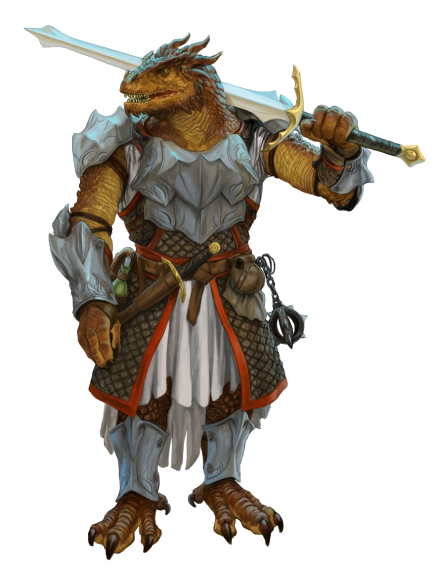Dragonborn
Dragonborn (also known as Strixiki in Draconic) are a race of draconic creatures not native to Winval. They instead originate in Laerakond. Physically and mentally strong, Dragonborns are decedents of dragons themselves.
Basic Information
Anatomy
Dragonborn resemble in many ways what their name suggests: humanoid dragons. Standing on average around 6'2" – 6'8", dragonborn are impressively tall with a heavy weight to match, commonly possessing a weight of 220–320 lbs. Dragonborn feet end with three strong talon-like claws with a fourth claw in the back, while their hands are similar with three claws with a thumb replacing the rear claw. A dragonborn's head features a blunt snout, a strong brow, and reptilian frills on the cheeks and ears. On the back of the head, a crest of hornlike scales form what resembled a mess of ropy hair. Dragonborn eyes are usually red or gold in hue.
Dragonborn exhibit many draconic features, including a scaly hide, a large muscular body, the capacity to use a breath weapon, and resistance to the same elemental energy they can breathe, thanks to their draconic heritage. Because of thousands of years of interbreeding, the scales a dragonborn wears acolour
Like dragons, dragonborn are often mistaken for reptiles, but are in fact warm-blooded draconic creatures. In fact, the internal body temperature of the dragonborn is warmer than that of most similar races, being so hot as to seem feverish to the human touch. While this might seem disadvantageous, the lack of hair and large mouth allows the dragonborn to displace body heat at an effective rate, meaning dragonborn are comfortable in cold climates while remaining no more vulnerable to heat than humans.
Growth Rate & Stages
Young dragonborn, who hatch from eggs like their draconic relatives, grow at an impressively rapid rate, much faster than most other races, reaching the equivalent maturity of a human child of 10 by age 3. Dragonborn nurse their hatchlings for several months before teeth begin to come in. A dragonborn will then slowly introduce soft food and then move towards normal dragonborn eating habits, which contains more meat than is typical of most other races.
Their rate of maturation slows dramatically within a few short years and they are not considered physically mature until the age 12, when their bodies reach their adult height and appearance. Not all dragonborn develop a breath weapon but those that do usually obtain it during these years of growth.
Psychologically, dragonborn are considered mature as a human adult by age 12, and when they reached age 15 they are considered legally adults in dragonborn society. Once they do reach adulthood, dragonborn can expect a lifespan identical to that of humans.
Additional Information
Social Structure
Clan and family bloodlines are both preserved among dragonborn and are highly important to dragonborn culture as a whole. Both are different, though the distinction is subtle to non-dragonborn. Family refers specifically to actual blood relatives, as far as can be traced, whereas clan, in the dragonborn context, refers to a confederation of families united by mutual purpose in ages past, organized along military lines. Of the two, clan is usually considered more important and it is to the clan that dragonborn owe their most loyalty.
Clans are led by wizened, aged clan-masters chosen for their ability to lead who are looked to for guidance by their lieges. Dragonborn do not forget the past, and ties to clan and family determin much about how one dragonborn is viewed by others. All clans have reputations, for good and ill, that often lasts for generations. A dragonborn's actions are expected to bring favour and good will to his or her clan, improving this reputation. For this reason, dragonborn typically go by their clan names rather than their family names, hoping to bring honour and glory to their clan. Dragonborn who worship gods are usually expelled from their clans because traditionalist dragonborn believe worshipping such beings is equal to selling themselves to dragon slavery again.
This pressure to either right the wrongs of the past or continue a clan's glory can define a dragonborn's life. Some dragonborn flee from the imposing responsibilities their clan put on them, choosing infamy over such a burden. Others accept the responsibility or even turn it into an additional drive for their ambition, hoping to one day become the clan-master.
Civilization and Culture
Culture and Cultural Heritage
The dragonborn drive for honor carries on into the culture of the race. Among dragonborn, the most horrible crime is oath-breaking; honesty is expected whenever a deal is struck. Commitment to a word is expected to be carried out to the letter and all parties in a transaction are held accountable and responsible for failings. Ultimately, those who fail to meet their word are expected to accept the consequences and, in fact, most dragonborn do so. So widespread is this value of honor and honesty that it is commonly believed that dragonborn never break their word.
Lifespan
80 years
Average Height
6'2" – 6'8"
Average Weight
220–320 lbs
Geographic Distribution
Remove these ads. Join the Worldbuilders Guild










Comments